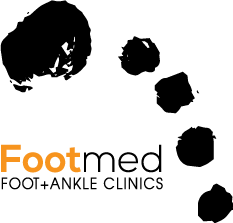Footmed Foot and Ankle Clinic provides a variety of quality services to treat hammertoes. We welcome patients from across Adelaide and Murray Bridge.
What is a hammertoe?
Hammertoe is a contracture – or a bending – of the middle joint of the second, third, fourth, or fifth toes. The toes have buckled making the top of the joint prominent. This causes rubbing on the joints making them red and painful. Painful corn or callus often develops at these pressure sites. If the toes have been in this position for a long time then arthritis can add to the pain experienced. Hammertoes can also create pressure, pain and callus under the ball of the foot referred to as metatarsalgia.
Hammertoe causes
The most common cause of hammertoe is a muscle/tendon imbalance. This imbalance, which leads to bending of the toe, results from mechanical (structural) changes in the foot that occurs over time in some people. Shoes that don’t fit properly often aggravate hammertoes. In some cases, ill-fitting shoes can actually cause the contracture. A hammertoe may develop if a toe is too long and is forced into a cramped position when a shoe is worn. Occasionally, hammertoe is caused by some kind of trauma such as a broken toe. In some people, hammertoes are inherited and can be due to diabetic myopathy, osteoarthritis and rheumatoid arthritis. Special consideration is necessary when a bunion accompanies a second hammertoe deformity. Bunion correction to minimise the risk of recurrence of the second toe is needed.
Hammertoe treatment
Pads, splints, foot orthoses, anti-inflammatory medication, debriding corns/callus and extra width/depth shoes can be used to provide comfort but is unlikely to straighten the toe. You can also choose to live with the problem. If the hammertoes interfere with daily activities and is affecting your quality of life despite these measures, it’s time to discuss surgical options.
Hammertoe surgery
A common surgical procedure performed to correct a hammertoe is called an arthroplasty. In this procedure, the surgeon removes a small section of the bone from the affected joint. If the contracture is severe it will require additional release of the joint capsule and tendon further up the front of the foot requiring a longer incision. Digital arthroplasty is always performed for a fifth hammertoe deformity to allow flexibility.
Correcting a hammertoe deformity is becoming increasing more common using minimal incision approach. This often involves releasing the tight tendons and making a cut through one or more bones of the toe using a bone cutting burr.
No screws or wires are required for these procedures.
The operation for severe hammertoe deformity requiring joint fusion has been shown to be satisfactory in a number of studies. Those conducted by Coughlin revealed 84% patient satisfaction after 5 yrs and 87% by Alvine & Galvin.
- Prolonged swelling (sausage toe)
- Floating toe
- Infection (smoking increases risk by 16X)
- Wound problems (slow to heal)
- Scar sensitivity
- Nerve Injury (nerves can be bruised which resolves but you can be left with permanent numbness)
- CRPS = Complex Regional Pain Syndrome (Rare <1%)
- Deep vein clots
Quite often hammertoes can be performed using a local anaesthetic, so we can reduce the risks associated with a general anaesthetic.
The operation is usually performed as day surgery in an accredited and licensed day hospital. A friend or family member must accompany you after any surgical procedure. You will be given a stiff soled shoe to wear over your bandages, which you must wear whenever you want to walk. You may begin increasing your activity to tolerance 2 days after your surgery. You should be able to return to normal footwear after 3-4 weeks. Your bandages need to be kept dry and you will be given an appointment to return to have the foot redressed in one week. You may be able to return to work from 3-6 weeks after the operation, depending on whether you need to stand or walk around a lot for your job. It is often not necessary to correct a hammertoe with screws or wires to keep them straight with the more reliable minimally invasive techniques available.

